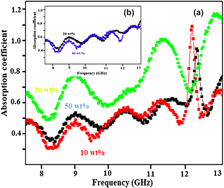Crossref Citations
This article has been cited by the following publications. This list is generated based on data provided by
Crossref.
Anuradha, Sindi
Roy, Aashis S.
and
Prasad, M.V.N. Ambika
2014.
Synthesis, characterization, and microwave properties of polypyrrole/molybdenum trioxide composites.
Science and Engineering of Composite Materials,
Vol. 21,
Issue. 4,
p.
479.
Anuradha, S.
and
Prasad, M. V. N. Ambika
2014.
Synthesis, Characterization, and X-Band Permittivity Studies of Polypyrrole–Zirconium Composite.
Spectroscopy Letters,
Vol. 47,
Issue. 9,
p.
723.
Sajjan, K. C.
Roy, Aashis S.
Parveen, Ameena
and
Khasim, Syed
2014.
Analysis of DC and AC properties of a humidity sensor based on polyaniline–chromium oxide composites.
Journal of Materials Science: Materials in Electronics,
Vol. 25,
Issue. 3,
p.
1237.
Lakshmi, Mohana
Roy, Aashish S.
Parveen, Ameena
Al-Hartomy, Omar A.
and
Khasim, Syed
2015.
Synthesis, characterization, and dielectric studies of ortho-chloropolyaniline–graphite oxide composites.
Journal of Materials Research,
Vol. 30,
Issue. 15,
p.
2310.
Jiang, J. J.
Li, D.
Li, S. J.
Wang, Z. H.
Wang, Y.
He, J.
Liu, W.
and
Zhang, Z. D.
2015.
Electromagnetic wave absorption and dielectric-modulation of metallic perovskite lanthanum nickel oxide.
RSC Advances,
Vol. 5,
Issue. 19,
p.
14584.
Nagaraju, S.C.
Roy, Aashis S.
and
Ramgopal, G.
2015.
Conductivity of surface modified TiO 2 dope nanocomposites.
Measurement,
Vol. 60,
Issue. ,
p.
214.
Nagaraju, S. C.
Roy, Aashis S.
Latha, A. L.
and
Ramgopal, G.
2015.
Synthesis, characterization and dielectric study of polyaniline – Pr2O3composites.
Ferroelectrics Letters Section,
Vol. 43,
Issue. 4-6,
p.
96.
Nagaraju, S. C.
Roy, Aashis S.
and
Ramgopal, G.
2015.
Dielectric Properties of Surface Modified TiO2Doped Ortho-chloropolyaniline Nanocomposites.
Ferroelectrics Letters Section,
Vol. 42,
Issue. 1-3,
p.
51.
Ansari, Juhi Nishat
Khasim, Syed
Parveen, Ameena
Al-Hartomy, Omar A
Khattari, Ziad
Badi, Nacer
and
Roy, Aashis. S.
2016.
Synthesis, characterization, dielectric and rectification properties of PANI/Nd2O3:Al2O3nanocomposites.
Polymers for Advanced Technologies,
Vol. 27,
Issue. 8,
p.
1064.
S., Kotresh
Y.T., Ravikiran
S.C., Vijaya Kumari
Ch.V.V., Ramana
and
K.M., Batoo
2017.
Solution based–spin cast processed LPG sensor at room temperature.
Sensors and Actuators A: Physical,
Vol. 263,
Issue. ,
p.
687.
Xing, Honglong
Yin, Qing
Liu, Zhenfeng
and
Wang, Lei
2017.
Excellent Microwave Absorption Behaviors of Polyaniline Composites Containing CeO2 Nanorods in the X-Band.
Nano,
Vol. 12,
Issue. 04,
p.
1750047.
Roy, Aashis S.
2018.
Antistatic and dielectric properties of one-dimensional Al2+:Nd2O3 nanowire doped polyaniline nanocomposites for electronic application.
Sensors and Actuators A: Physical,
Vol. 280,
Issue. ,
p.
1.
Megha, R.
Ravikiran, Y.T.
Vijaya Kumari, S.C.
Chandrasekhar, T.
and
Thomas, S.
2018.
Optimized polyaniline‐transition metal oxide composites: A comparative study of alternating current conductivity via correlated barrier hopping model.
Polymer Composites,
Vol. 39,
Issue. 10,
p.
3545.
Dalal, Jasvir
Lather, Sushma
Gupta, Anjli
Dahiya, Sajjan
Maan, A.S.
Singh, Kuldeep
Dhawan, S.K.
and
Ohlan, Anil
2018.
EMI shielding properties of laminated graphene and PbTiO3 reinforced poly(3,4-ethylenedioxythiophene) nanocomposites.
Composites Science and Technology,
Vol. 165,
Issue. ,
p.
222.
Parveen, Ameena
Manjunatha, S.
Kumar, M. Madesh
and
Roy, Aashis S.
2024.
Agile soft template array fabrication of one-dimensional (1D) polyaniline nanocomposite fibers for hydrogen storage.
RSC Advances,
Vol. 14,
Issue. 35,
p.
25347.
